CBSE Sample Papers for Class 11 Biology Set-5
Class 11thCBSE Sample Papers for Class 11 Biology Set-5
CBSE Sample Papers for Class 11 Biology Set 5 with Solutions
Time : 3 Hours
Maximum Marks : 70
General Instructions:
- All questions are compulsory.
- The question paper has five sections and 33 questions. All questions are compulsory.
- Section – A has 16 questions of 1 mark each; Section – B has 5 questions of 2 marks each; Section – C has 7 questions of 3 marks each; Section- D has 2 case – based questions of 4 marks each; and Section – E has 3 questions of 5 marks each.
- There is no overall choice. However, internal choices have been provided in some questions. A student has to attempt only one of the alternatives in such questions.
- Wherever necessary, neat and properly labeled diagrams should be drawn.
Section – A
Question 1.
A person breathes in some volume of air by forced inspiration
after having a forced expiration. This quantity of air
taken in is: (1)
(A) Total lung capacity
(B) Tidal volume
(C) Vital capacity
(D)
Inspiratory capacity
Answer:
Option (C) is correct.
Explanation: Vital
capacity is the maximum volume of air a person can breathe in after a forced
expiration. VC = ERV + TV + IRV here, EVR is Expiratory reserve volume, TV is
Tidal volume, and IRV is Inspiratory Reserve volume.
Question 2.
Ethylene is used for (1)
(A) Retarding ripening of
tomatoes
(B) Hastening of ripening of fruits
(C) Slowing down the ripening
of apples
(D) Both (B) and (C)
Answer:
Option (B) is correct.
Explanation: Ethylene is gaseous hormone which is i also called fruit ripening
hormone. It stimulate the biochemical changes for fruit ripening.
Question 3.
Match the following and choose the correct option: (1)
| Group A | Group B |
| (a) Aleurone layer | (i) Without fertilisation |
| (b) Parthenocarpic fruit | (ii) Nutrition |
| (c) Ovule | (iii) Double fertilisation |
| (d) Endosperm | (iv) Seed |
(A) a – i, b – ii, c – iii, d – iv
(B) a – ii, b – i, c – iv, d – iii
(C) a – iv, b – ii, c – i, d – iii
(D) a – ii, b – iv, c- i, d – iii
Answer:
Option (B) is correct.
| Group A | Group B |
| (a) Aleurone layer | (ii) Nutrition |
| (b) Parthenocarpic fruit | (i) Without fertilisation |
| (c) Ovule | (iv) Seed |
| (d) Endosperm | (iii) Double fertilisation |
Question 4.
The role of ABA is antagonistic to: (1)
(A) Ethylene
(B)
Gibberellic acid
(C) Cytokinin
(D) IAA
Answer:
Option (B) is
correct.
Explanation: Gibberellic acid is antagonotstic to ABA because of
some anti characteristics such as
(i) ABA inhibits growth of the plant While
gibberellin promotes growth.
(ii) ABA promotes Leaf senescence while
gibberrelin prevent leaf senescence.
Question 5.
Potential difference across resting membrane is negatively
charged. This is due to differential distribution of the
following ions.
(1)
(A) Na+ and K+ ions
(B) CO3 and
Cl– ions
(C) Ca++ and Mg++ ions
(D)
Ca4+and Cl– ions.
Answer:
Option (A) is correct.
Explanation: In a neuron the potential difference across resting membrane
maintained by sodium and potassium ions. The ion channels control the movement
of sodium and potassium ions in both inner and outer side of a neuron.
Question 6.
Corpus luteum secretes a hormone called: (1)
(A)
Prolactin
(B) Progesterone
(C) Aldosterone
(D) Testosterone
Answer:
Option (B) is correct.
Explanation: progesterone is secreted by
ovaries as corpus leutem is part of an ovary so the hormone is progesterone.
Question 7.
A fully grown tadpole larva of a frog respires through:
(1)
(A) Gills
(B) Skin
(C) Lungs
(D) Tail fin
Answer:
Option
(A) is correct.
Explanation: Frog is an amphibian and shows metamorphosis .
At tadpole stage its respire through gills in water.
Question 8.
Identify the phylum among the following, in which adults
exhibit this type of symmetry but, their larvae exhibit
different symmetry.
(1)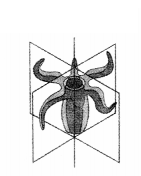
(A) Porifera
(B) Coelenterata
(C) Aschelminthes
(D)
Echinodermata
Answer:
Option (D) is correct.
Explanation:
Echinodermates adult have radial symmetry while their larvae has bilateral
symmetry, as shown in the figure.
Question 9.
Which range of wavelength (in nm) is called photosynthetically
active radiation (PAR)? (1)
(A) 100 – 390
(B) 390 – 430
(C) 400 –
700
(D) 760 – 100,00
Answer:
Option (C) is correct.
Explanation:
Photo synthetically active radiation (PAR) is the light of wavelength 400-700 nm
and this portion of light is utilised by the plants for photosynthesis.
Question 10.
Identify the ‘pacemaker’ of the heart from the given
diagram.
(A) (iii)
(B) (iv)
(C) (i)
(D) (ii)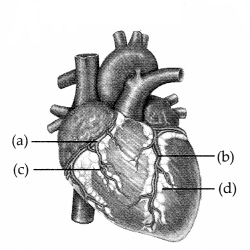
Answer:
Option (C) is correct.
Explanation: Label (a) shows the SA
(sinoauricular node) which is also called pace maker of human heart, which is
responsible to generate impulses.
Question 11.
Many physico-chemical processes are enzyme-mediated. Which of
the following reactions is not enzyme-mediated in biological system? (1)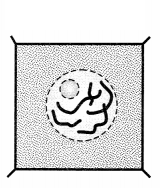
(A) Dissolving CO2 in water
(B) Untwining the
two strands of DNA
(C) Hydrolysis of sucrose
(D) Formation of peptide
bond
Answer:
Option (A) is correct.
Explanation: CO2
Dissolution is non-enzymatic reaction while to unwinding of two strands enzyme
topoisomerase is used, to hydrolyse sucrose enzyme sucrase is used and to form
peptide bonds enzyme peptidyl transferase is used.
Question 12.
Identify the given stage shown in the diagram : (1)
(A)
Late prophase
(B) Early Prophase
(C) Interphase
(D) Metaphase.
Answer:
Option (A) is correct.
Explanation: The given diagram shows late
prophase stage of cell cycle in which nuclear membrane get dissolved and
chromosomes get more condensed and visible.
Directions: In the following questions, A statement of Assertion (A) is
followed by a statement of Reason (R). Mark the correct choice as:
(A) Both A
and R are true and R is the correct explanation of A.
(B) Both A and R are
true but R is NOT the correct explanation of A.
(C) A is true but R is
false.
(D) A is false but R is true.
Question 13.
Assertion (A): Bryophytes are successful land plants. (1)
Reason (R): They grow successfully on land but require water for the completion
of their life cycle.
Answer:
Option (D) is correct.
Explanation:
Bryophytes are amphibians of plant kingdom. They grow on moist habitats and
require water for reproduction.
Question 14.
Assertion (A): Arthritis or inflammation of a joint makes the
joint painful. (1)
Reason (R): Some toxic substances are deposited at the
joint.
Answer:
Option (C) is correct.
Explanation .-Due to the
deposition of uric acid in joints the movement of joint become painful
Question 15.
Assertion (A): Nephridia are present in earthworms. (1)
Reason (R): They help in respiration.
Answer:
Option (C) is correct.
Explanation: Nephridia is excretory organs present in earthworm.
Question 16.
Assertion (A): Mitochondria help in cellular respiration
(1)
Reason (R): Mitochondria have enzymes for dark reaction.
Answer:
Option (C) is correct.
Explanation: Mitochondria help in cellular respiration
by transferring energy from organic compounds to ATE Chloroplast helps in
photosynthesis. The dark reaction takes place in the stroma of the
chloroplast.
Section – B
Question 17.
‘Omnis cellula-e-cellula’. Who gave this statement and what
does it mean ? (2)
Answer:
‘Rudolf Virchow’ gave this statement. It means
“All cells come from pre-existing cells”. Every cell is born from previous cell,
which was born from a previous cell. Life comes from life.’
Question 18.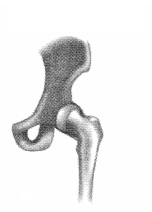
(a) Name the type of joint represented in the given diagram.
(2)
(b) What is the significance of the fluid present between this type of
joint?
Answer:
(a) Synovial Joint.
(b) There is a membrane present
called synovial membrane, which is composed of secretory epithelial cells which
secrete a thick sticky fluid, of the consistency of the white of an egg called
synovial fluid.
It acts as a lubricant to the joint, provides nutrient
materials for the structures within the joint cavity and helps to maintain the
stability of the joint.
Question 19.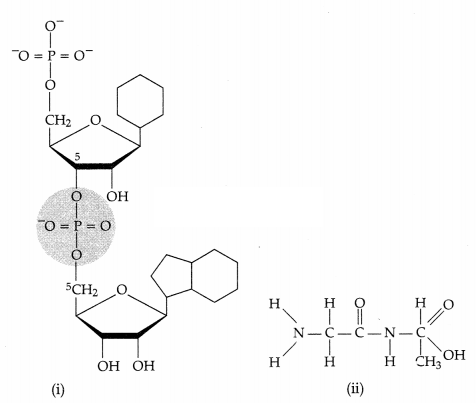
(a) Name the type of bond highlighted in the given diagram (i) and (ii). (2)
(b) Define each type of bond highlighted in the given diagram (i) and (ii),
respectively.
Answer:
(a) (i) Phosphodiester bond.
(ii) Peptide
bond.
(b) (i) Peptide bond is a covalent bond that joins the two amino acids by
-NH-CO linkage.
(ii) Phosphodiester bond is a strong covalent bond between
phosphate and two sugar groups.
Question 20.
(a) What is placentation? (2)
(b) Identify the given type
of placentation.
Answer:
(a) The number, position and arrangement or
distribution of placenta inside an ovary is called placentation. It is of the
following types:
- Marginal
- Parietal
- Axile
- Free central
- Basal
- Apical and
- Superficial.
(b) Axile placentation.
Question 21.
Endoparasites are found inside the host body. They live in
their tissues and internal organs and survive on their nutrition. (2)
(a)
Mention the special structure, possessed by these parasites.
(b) How these
structures help the host survive in those conditions.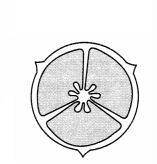
OR
(a) Study the given table and
Fill up the spaces
appropriately.
| Phylum/Class | Excretory organ | Circulatory organ | Respiratory organ |
| Arthropoda | Lungs/Gills/Tracheal system | ||
| Nephridia | Closed | Skin/Parapodia | |
| Metanephridia | Open | ||
| Amphibia | Closed | Lung |
(b) Define the scientific term used for cold-blooded animals .
Answer:
(a) Hook and Suckers.
(b) Special characters present in endoparasites are as follows:
- Presence of adhesive organ for attachment to the host. Fasciola hepatica possesses posterior sucker for attachment. Taenia solium possess hook and suckers for the attachment within the host.
- Presence of thick integument which is resistant to host’s digestive enzymes and antitoxin.
- Absence of locomotory organs.
- Lack of digestive organs because digested and semi-digested food of the host is directly absorbed through their body surface.
- They are generally hermaphrodite.
OR
(a)
| Phylum/ Class | Excretory organ |
Circulatory organ | Respiratory organ |
| Arthropoda
|
Malpighian tubule | Open | Lungs/Gills/Tracheal system |
| Annelida | Nephridia | Closed | Skin/parapodia |
| Mollusca | Metane- phridia | Open | Gills/Mantle, Pulmonary sac |
| Amphibia | Kidneys | Closed | Lung |
(b) Poikilotherms; their body temperature varies with the varying environment.
Section – C
Question 22.
(a) Label the given diagram of VS. of maize seed: (3)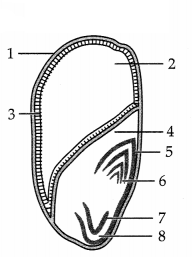
(b) Write down the function of part (2.)
Answer: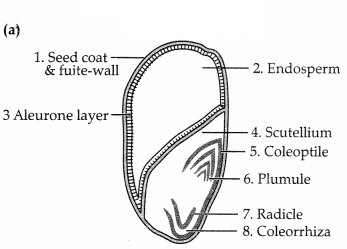
(b) Aleurone layer is a sheath of special tissue. It contains proteins, which
helps in the nourishment of developing embryo enclosed in the seed. It also
secretes a few enzymes which help in the process of seed germination.
Question 23.
How diabetes insipidus is different from diabetes mellitus ?
(3)
Answer:
Deficiency of ADH leads to diabetes insipidus, a condition
marked by the output of huge amounts of urine and intense thirst. The name
itself (diabetes =overflow; insipidus = tasteless) distinguishes it from
diabetes mellitus (mel = honey), in which insulin deficiency causes large
amounts of blood sugar to be lost in the urine.
Question 24.
The process of respiration requires oxygen. In plants, oxygen
is taken in by stomata, lenticels and root hairs. During the process of
respiration, oxygen is utilised and carbon dioxide and water is released along
with energy molecules in form of ATP.
(a) What are the two crucial events in
anaerobic respiration? Where does these take place? (3)
(b) Why anaerobic
respiration yields much less energy than aerobic respiration?
(b) Name the
part which helps in cross-bridge formation.
Answer:
(a) The two important
events in aerobic respiration are:
(a) Complete oxidation of pyruvate in the
matrix of mitochondria, all this happens by step¬wise removal of hydrogen atoms,
and finally carbon dioxide is left.
(b) Electron removes as part of hydrogen
atoms passed on to molecular oxygen and ATP formed simultaneously.
(b) Anaerobic respiration yields much less energy than aerobic respiration. The main reasons are:
- There is an incomplete breakdown of the respiratory substrate.
- One of the end products of anaerobic respiration is organic which still contains energy.
- NADH2 produced during glycolysis is often re-utilized.
- Regeneration of NAD+ from NADH2 does not produce ATP.
- Electron transport chain is absent.
- Oxygen is not used for accepting electrons and protons.
Question 25.
(a) Label the different components of actin filament in the
diagram given below. (3)
(b) Name the part which helps in cross-bridge formation.
Answer:
(b) F-Actin.
Question 26.
Mention the initial fixation in C4 pathway.
(3)
Answer:
(i) Initial fixation of CO2 occurs in mesophyll
cells.
(ii) The primary acceptor of CO2 is phosphoenol pyruvate or PEP.
It combines with CO2 in the presence of PEP carboxylase to form
oxaloacetic acid or oxaloacetate.
PEP + CO2 + H2O →
Oxaloacetic acid + H3PO4
(iii) Oxaloacetic acid is reduced to malic acid or transaminated to form
aspartic acid.
Oxaloacetic acid + NADPH Dehydrogenase → Malic acid +
H3PO4
Oxaloacetic acid + Alanine Transaminase →
Aspartic acid + Pyruvic acid
Question 27.
Under high concentration of O2, RuBP binds with
O2 and forms one molecule of phosphoglycerate and phosphoglycolate.
(3)
(a) What is this process called?
(b) Why is this process called a
wasteful process?
(c) Name three cell organelles involved in this
process.
OR
The term glycolysis originated from the Greek words, glycos
for sugar and lysis for splitting. It is a metabolic pathway given by G. Embden,
Otto Meyerhoff, and J. Parna Spl
(a) (i) Where does glycolysis occur in the
cell?
(ii) Mention the end product.
(b) Which intermediate compound is a
connecting link between glycolysis and Kreb’s cycle?
Answer:
(a)
Photorespiration
(b) Photorespiration is called a wasteful process because:
- No energy is produced in this process.
- Oxygen is consumed for nothing.
- H2O2 is produced which is highly toxic.
- The yield of photosynthesis is reduced to 50%.
(c) Chloroplast, Mitochondria and Peroxisomes
OR
(a)
(i) Glycolysis:
Glycolysis means “the splitting of sugar”. A glucose molecule is converted into
2 molecules of pyruvic acid during glycolysis. It occurs in the cytoplasm of the
cell.
(ii) End products are 2 pyruvate molecules and 2 ATP molecules.
(b) Acetyl CoA is a connecting link between glycolysis and kreb’s cycle.
Question 28.
Why bryophytes do not attain great heights? (3)
Answer:
Bryophytes seldom achieve great heights. The possible reasons
are:
- Absence of roots.
- Materials are transported from cell to cell.
- Absence of vascular tissues.
- Absence of cuticle on the plant body.
- Requirement of an external sheet of water for capillary conduction to all parts and transport of male gametes.
Section – D
Question 29.
Study the given structure of cyanobacteria and answer the
following questions:
(a) Name the reserve food material in cyanobacteria.
OR
Name the type of substance which surrounds the colonies of blue-green
algae.
(b) (i) Name the pigments present in cyanobacteria.
(ii) Name the
type of reproduction through which blue green algae reproduces.
(c) Name the
kingdom which includes cyanobacteria. (4)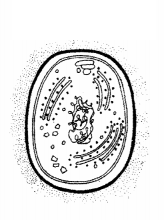
Answer:
(a) Oil droplets.
OR
Gelatinous sheath
(b) (i) The pigments present in cyanobacteria are: Chlorophyll ‘a’,
phycobilin, phycoerythrin and phycocyanin.
(ii) Blue-green algae multiply
asexually by binary fission, fragmentation or by the formation of small segments
called hormogonia.
• Typical sexual reproduction is absent.
(c) Kingdom Monera.
Question 30.
| S. No. | Major pigments | Stored food | Cell wall | Flagellar number and position of insertion |
| 1. | chlorophyll a, b | Starch | Cellulose | 2 – 8, equal apical |
| 2. | chlorophyll a, c, fucoxanthin | Cellulose and algin | 2, unequal lateral | |
| 3. | chlorophyll a, d, phycoerythrin | Floridean starch | Absent |
(a) Write the common names for the groups respective to their characteristics
from the given table.
(b) Write the stored food material for group ‘2’.
(c) Write the cell wall composition for group ‘3’. (4)
OR
There are
millions of living organisms on earth. All these living organisms differ in
shape, size, colour, habitat and many other characteristics. To understand their
origin, diversity, distribution and interrelationship, the scientists have
devised mechanisms to classify all of them. Classification of living organisms
help in revealing the relationship between various organisms. It also helps in
making the study of organisms easy and organised.
(a) Name the scientist w’ho
made a significant contribution of field of classification.
(b) All living
organisms are linked to one another. Why?
(c) What is the important criteria
in the present day classification?
Answer:
(a)
(i) Green Algae
(ii)
Brown Algae
(iii) Red Algae
(b) Mannitol, laminarin.
(c) Cellulose, pectin, and sulphate esters.
OR
(a) Linnaeus made
significant contribution in the field of classification.
(b) All living organisms are linked to one another because they share common genetic material but to varying degrees. Living organisms share common genetic material to some extent of varying degrees and hence they linked to one another.
(c) An important criteria in the present day classification is: Anatomical and physiological traits.
Section – E
Question 31.
On the basis of the given table answer the following
questions: (5)
| S. No. | Red muscle fibre | White muscle fibre |
| (i) | They are thin and smaller in size. | They are thick and larger in size. |
| (b) | They are red in colour. | They are white in colour. |
| (iii) | They contain numerous mitochondria. | They contain less number of mitochondria. |
| (iv) | They carry out slow and sustained contractions for a long period. | They carry out fast work for short duration. |
| (v) | They do not undergo fatigue. | They undergo early fatigue. |
(a) Why red muscle fibre are red in colour?
(b) What is muscle fatigue?
How is it caused?
(c) Give examples of both the muscle fibre.
OR
In the
following diagram shows the myofibrils in different state of action. Answer the
questions as follows: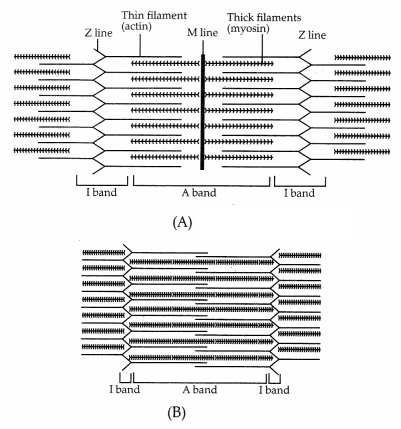
(a) What is the state of myofibrils in (A) and (B) respectively?
(b) What are
I band and A band also called as respectively?
(c) Which ion is responsible
for contraction or relaxation of myofibrils
Answer:
(a) Red muscle fibres
are red in colour due to large amounts of myoglobin content present in them.
(b) The reduction in muscle contraction force after prolonged stimulation is
called muscle fatigue.
(i) A muscle is able to contract for a short time in
the absence of oxygen. But it gets fatigue sooner because the metabolic products
of glycolysis mainly lactic acid accumulate, in the absence of oxygen.
(ii)
The accumulation of lactic acid leads to muscle fatigue.
(c)
| Red muscle fibre | White muscle fibre |
| Example: Flight muscles of birds like kites, Extensor muscles of the back to maintain erect posture of the body | Example: Muscles of the eyeball and flight muscles of birds like sparrow. |
OR
(a) (a) is relaxed state and (B) is contracted state of myofibril.
(b) I band is light band or isotropic band while A band is dark band or
anisotropic band.
(c) Ca2+ ions are responsible for the
contraction or relaxation of myofibril.
Question 32.
Eukaryotic cells are present in protista, plants, animals and
fungi. Cytoplasm is divided into compartments due to
the presence of membrane
bound organelles. (5)
(a) Name two cell-organelles that are double membrane
bound.
(b) What are the characteristics of these two organelles?
(c) State
their functions and draw labelled diagrams of both.
OR
The genetic
material is contained in the chromosomes of the cell. The chromosome has
different parts; arms, secondary constrictions, and centromere.
(a) What is a
centromere?
(b) How does the position of centromere form the basis of
classification of chromosomes?
(c) Support your answer with a diagram showing
the position of centromere on different types of chromosomes.
Answer:
(a)
Mitochondria and chloroplast.
(b) Mitochondria:
- Each mitochondrion is a double membrane- bound structure with the outer membrane and the inner membrane.
- The outer membrane forms the continuous limiting boundary of the organelle whereas the inner membrane forms a number of infolding called the cristae. The cristae increase the surface area.
- The matrix possesses a single circular DNA molecule, a few RNA molecules and 70S ribosomes.
Chloroplast:
- The chloroplast are double membrane structures. They are divided into outer and inner membranes, further divided into two distinct regions: Grana and stroma.
- Between the outer and inner membranes, intermembrane space is present.
- The inside of the chloroplast is clearly marked into a colourless ground matrix called stroma.
- A number of organised flattened membranous sacs called thylakoids are present in the stroma.
- Thylakoids are arranged in stacks called grana. Besides these, there are flat membranous tubules called the stroma lamellae connecting the thylakoids of the different grana.
- The stroma of the chloroplast contains small, double-stranded circular DNA and 70S ribosomes.
(c) Mitochondria – Function:
(i) Mitochondria are the sites of aerobic
respiration and produce cellular energy in the form of ATP, hence they are
called powerhouses of the cell.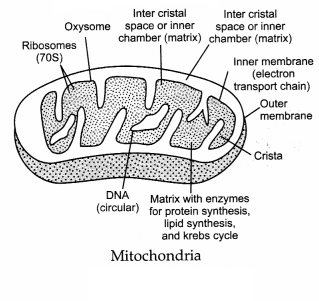
Chloroplast- Functions:
(i) Chloroplasts are the centres of
photosynthesis.
(ii) They are able to trap solar energy and convert it into
chemical energy.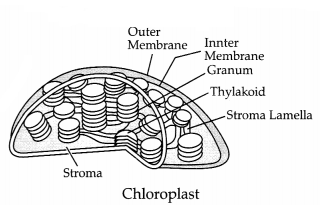
OR
(a) Centromere is the constriction present on the chromosomes, where
chromatids are held together.
(b) Chromosomes are divided into four types based on the position of centromere:
- Metacentric chromosome: The chromosome in which the centromere is present in the middle and divides the chromosome into two equal arms is known as a metacentric chromosome.
- Sub-metacentric chromosome: The chromosome in which the centromere is slightly away from the middle region is known as a sub-metacentric chromosome. In this, one arm is slightly longer than the other.
- Acrocentric chromosome: The chromosome in which the centromere is located close to one of the terminal ends is known as an acrocentric chromosome. In this, one arm is extremely long and the other is extremely short.
- Telocentric chromosome: The chromosome in which the centromere is located at one of the terminal ends is known as a telocentric chromosome.
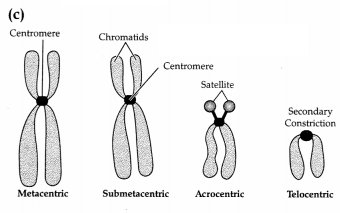
Question 33.
Explain briefly the structural levels of proteins. (5)
OR
What are the methods of passage of substances across the cell
membrane?
Answer:
Proteins are macromolecules having one or more
polypeptide chains of amino acids. These are highly organised linear polymers of
amino acids. Proteins have four structural levels – primary, secondary, tertiary
and quaternary.
(i) Primary structure: The linear sequence of amino acids in a polypeptide chain is the primary structure of protein. The first amino acid is called N-terminus and the last amino acid is called C-terminus.
(ii) Secondary structure: The polypeptide chains are coiled or folded in the form of helix. The structure is maintained by a series of regularly spaced infra or inter molecular hydrogen bonds formed between the amino acids of the same or different polypeptide chains. Such a conformation is termed as secondary structure. There are 3 types of secondary structure, α – helix, β -pleated and collagen helix.
(iii) Tertiary structure: The helical polypeptide molecules further coiled to assume a complex but specific form called tertiary structure. They are so arranged as to hide non-polar amino acid inside and expose the polar side chains. These structure are maintained by several types of bonds such as hydrogen bonds, Van der Waal interaction, ionic bonds, disulphide bonds, etc., between the polypeptide chains.
(iv) Quaternary structure: Each polypeptide develops its own tertiary
structure and functions as subunit of the protein. The different charged
subunits pack together to give specific conformation. Large proteins such as
haemoglobin have a quaternary structure. It has four chains, two α-chains and
two β – chains.
OR
The passage of substances across the cell membrane
occurs by three methods:
(i) Passive transport: It is a mode of membrane
transport which occurs without the expenditure of cell energy. Passive transport
occurs by diffusion or osmosis. Neutral solutes may move across the membrane by
the process of simple diffusion along the concentration gradient. Osmosis is a
special type of diffusion in which only water molecules migrate across a semi-
permeable membrane from the area of high concentration to the area of low
concentration.
(ii) Active transport: It is the movement of materials across the membrane against the concentration gradient. This often leads to accumulation of substances at a higher concentration within the cell than outside. Energy is required for such a process, which is usually provided by ATP. There are certain proteins in the membrane, which acts as a carrier molecules or carrier proteins. It has a binding site for the substrate. This transports the carrier-bound substrate to the other side of the membrane.
(iii) Bulk transport: It includes exocytosis and endocytosis, which are the processes for active cellular extrusion and intake respectively of such materials that cannot pass through the unbroken plasma membrane. Both the processes involve movement and folding of the membrane, which depends on its fluidity and mobility.